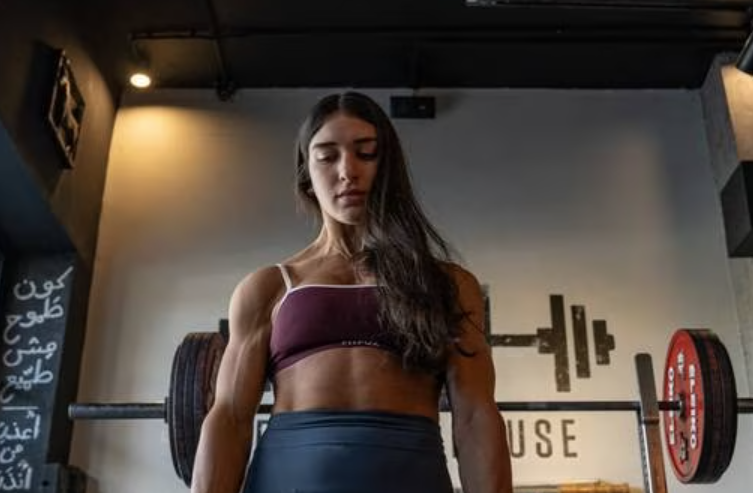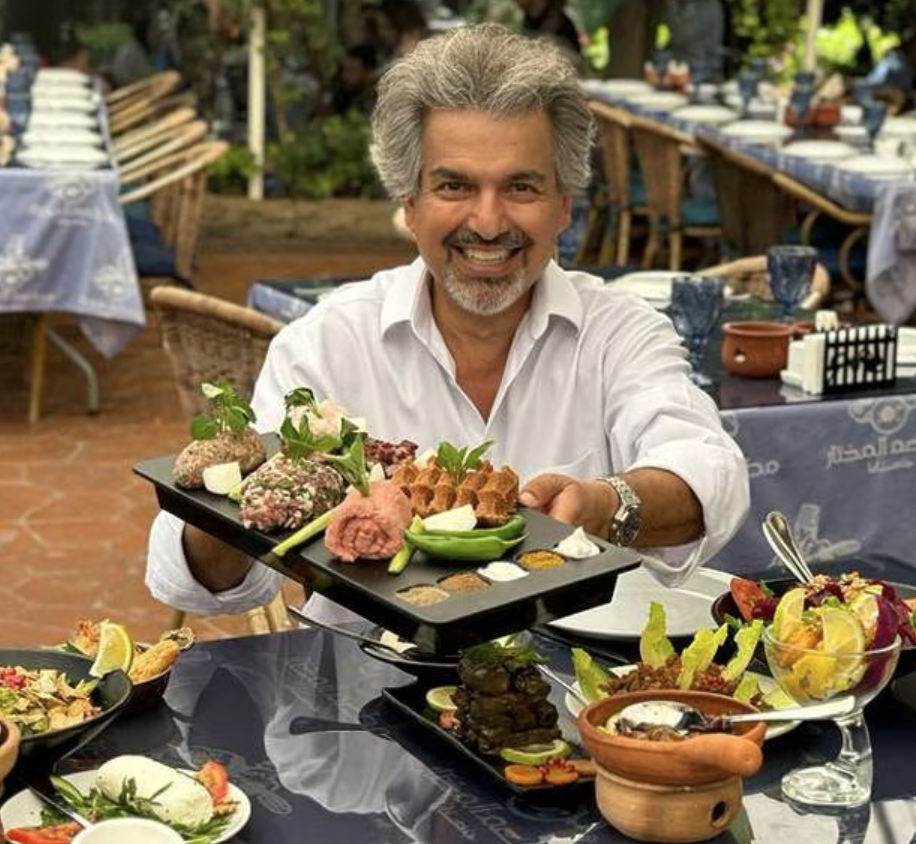
by Nada Maucourant Atallah -- thenationalnews.com -- When she stepped on to the platform amid enthusiastic cheers from her supporters, Lebanese powerlifter Joya Khairallah, 22, was faced with a steel bar loaded with several red plates weighing an impressive total of 183.5kg. This was an immense challenge for the young woman, weighing only 52kg, but she had to overcome it if she wanted to claim first-place at the 2023 International Powerlifting Federation (IPF) World Junior Championships. No one in her category had ever accomplished this feat, until August 29 in Cluj-Napoca in Romania, when Miss Khairallah firmly grasped the heavy bar and pulled it from the ground level to her hips, a movement called a “deadlift” - one of three lifts performed in powerlifting.
When she reached the lockout position, marking the end of the movement, she screamed in triumph and knelt to the floor, having just broken the world record. “After stepping on to the platform, I initially had doubts because I was exhausted, and my back was hurting, but I persevered, I got it and I won,” she told The National in Beirut during her first training session, a few days after the international competition. “There's no actual word that really describes how I felt. It feels wonderful, but I'm still a bit in denial,” she added. The Lebanese champion achieved a total of 428.5kg for the three lifts (bench, squat, and deadlift), setting yet another IPF Junior World Record in her weight class.

by venturebeat.com -- Gary Grossman Edelman - Generative AI is gaining wider adoption, particularly in business. Most recently, for instance, Walmart announced that it is rolling-out a gen AI app to 50,000 non-store employees. As reported by Axios, the app combines data from Walmart with third-party large language models (LLM) and can help employees with a range of tasks, from speeding up the drafting process, to serving as a creative partner, to summarizing large documents and more. Deployments such as this are helping to drive demand for graphical processing units (GPUs) needed to train powerful deep learning models. GPUs are specialized computing processors that execute programming instructions in parallel instead of sequentially — as do traditional central processing units (CPUs). According to the Wall Street Journal, training these models “can cost companies billions of dollars, thanks to the large volumes of data they need to ingest and analyze.” This includes all deep learning and foundational LLMs from GPT-4 to LaMDA — which power the ChatGPT and Bard chatbot applications, respectively.
Riding the generative AI wave
The gen AI trend is providing powerful momentum for Nvidia, the dominant supplier of these GPUs: The company announced eye-popping earnings for their most recent quarter. At least for Nvidia, it is a time of exuberance, as it seems nearly everyone is trying to get ahold of their GPUs. Erin Griffiths wrote in the New York Times that start-ups and investors are taking extraordinary measures to obtain these chips: “More than money, engineering talent, hype or even profits, tech companies this year are desperate for GPUs.” In his Stratechery newsletter this week, Ben Thompson refers to this as “Nvidia on the Mountaintop.” Adding to the momentum, Google and Nvidia announced a partnership whereby Google’s cloud customers will have greater access to technology powered by Nvidia’s GPUs. All of this points to the current scarcity of these chips in the face of surging demand. Does this current demand mark the peak moment for gen AI, or might it instead point to the beginning of the next wave of its development?
How generative tech is shaping the future of computing
by Zlatan Hrvacevic — The Port of Beirut has historically played a vital role in Lebanon’s economy, as a major cargo and …

By Liza Ayach -- Thenationalnews.com -- I have been following Luai Ahmad Alkilani on social media for some time now. A big reason why he's captured my admiration is because, despite being Kuwaiti, he showcases life in Lebanon more fervently than the Lebanese themselves, especially the cuisine. When I reach out to the businessman-turned-blogger, he tells me his love affair with the country began in his childhood when his parents used to whisk him away to the scenic hills of Bhamdoun, Falougha and Hammana for summer getaways. Now 56, Alkilani has woven a bond with the country that transcends both time and nationality. While his first wife is Kuwaiti, Alkilani's second wife is Lebanese, solidifying his deep-rooted attachment to the country. “Kuwait is where I primarily reside, but I often travel to Lebanon and typically dedicate my entire summer to being there,” says Alkilani. "My family, children and friends also cherish the country due to my frequent visits and extensive explorations.
In Lebanon, you can swim by the shore and dine in the mountains within a 45-minute drive. A self-professed “food enthusiast", Alkilani says his adoration for Lebanese dishes sparked his mission to advocate cross-cultural gastronomy. “I adore Lebanese food in all its varieties,” he says, with his favourites spanning street food classics such as mankoushe and falafel to delicacies served at fine-dining restaurants. “I often contemplate crafting fusion dishes that combine Kuwaiti and Lebanese flavours, to satisfy people from both nations," he adds. "These creations would blend Levantine-spiced rice with signature Gulf sauces, for a culinary blend that could yield exquisite, innovative dishes for dining tables across the region.”
Khazen History


Historical Feature:
Churches and Monasteries of the Khazen family

St. Anthony of Padua Church in Ballouneh
Mar Abda Church in Bakaatit Kanaan
Saint Michael Church in Bkaatouta
Saint Therese Church in Qolayaat
Saint Simeon Stylites (مار سمعان العامودي) Church In Ajaltoun
Virgin Mary Church (سيدة المعونات) in Sheilé
Assumption of Mary Church in Ballouneh
1 - The sword of the Maronite Prince
2 - LES KHAZEN CONSULS DE FRANCE
3 - LES MARONITES & LES KHAZEN
4 - LES MAAN & LES KHAZEN
5 - ORIGINE DE LA FAMILLE
Population Movements to Keserwan - The Khazens and The Maans
ما جاء عن الثورة في المقاطعة الكسروانية
ثورة أهالي كسروان على المشايخ الخوازنة وأسبابها
Origins of the "Prince of Maronite" Title
Growing diversity: the Khazin sheiks and the clergy in the first decades of the 18th century
Historical Members:
Barbar Beik El Khazen [English]
Patriach Toubia Kaiss El Khazen(Biography & Life Part1 Part2) (Arabic)
Patriach Youssef Dargham El Khazen (Cont'd)
Cheikh Bishara Jafal El Khazen
Patriarch Youssef Raji El Khazen
The Martyrs Cheikh Philippe & Cheikh Farid El Khazen
Cheikh Nawfal El Khazen (Consul De France)
Cheikh Hossun El Khazen (Consul De France)
Cheikh Abou-Nawfal El Khazen (Consul De France)
Cheikh Francis Abee Nader & his son Yousef
Cheikh Abou-Kanso El Khazen (Consul De France)
Cheikh Abou Nader El Khazen
Cheikh Chafic El Khazen
Cheikh Keserwan El Khazen
Cheikh Serhal El Khazen [English]
Cheikh Rafiq El Khazen [English]
Cheikh Hanna El Khazen
Cheikha Arzi El Khazen
Marie El Khazen